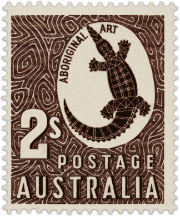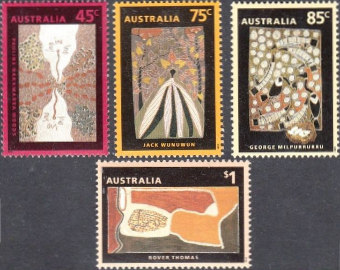History
Timeline results for 1400 to 2023
Found 52 results for your search. Showing page 1 of 3.
Year from 1400, year to 2023, month is February
1836
-
Triggered by accounts of the mistreatment of Aboriginal people by British colonists, the British House of Commons orders an inquiry and appoints a select committee to review the treatment of Aboriginal people by British subjects throughout the Empire.
-
King William IV recognises the continued rights to land for Aboriginal people in South Australia’s founding document, the Letters Patent. It was the first ever recognition of Aboriginal rights granted in Australia’s colonial history. But the promise of legal entitlement to the land was never kept.
1868
-
An an all-Aboriginal cricket team of men from lands of western Victoria embarks on a tour of England, backed by private financiers.
1939
-
The first-ever mass strike of Aboriginal people in Australia occurs, called the Cummeragunja Walk-off. Over 150 Aboriginal people pack-up and leave Cummeragunja Aboriginal Station in protest at the cruel treatment and exploitation of residents by the management. They walk 66kms and cross the border from New South Wales into Victoria in contravention of the rules of the New South Wales Protection Board. The opera Pecan Summer tells the story of the walk-off.
1948
-

Designed by a non-Aboriginal artist, this 2-shilling stamp is the first to show an Aboriginal art theme. Australia Post releases the first Australian stamp that features an Aboriginal art theme. The 2 shilling stamp represents a crocodile in the style of a rock painting and is part of the Australian Animals definitive stamp issue of that year. But the artist, Gert Sellheim, is not Aboriginal.
1949
-
A group of Aboriginal stockmen including Ampilatwatja man Banjo Morton walk off from the Lake Nash Cattle Station demanding wages instead of rations. After a short period they are paid one pound a week. It is the first time Aboriginal stockmen walked off disputing labour conditions in the NT.
1958
-
Federal Council for the Advancement of Aborigines is set up. It group brings together a number of civil rights and Aboriginal welfare organisations. Its work plays a large part in bringing about the 1967 referendum. In 1964 the title changes to Federal Council for the Advancement of Aborigines and Torres Strait Islanders (FCAATSI).
1965
-
From 12 to 26 February, Charles Perkins leads a freedom ride by Aboriginal people and students through north-western New South Wales in support of Aboriginal rights. The protesters want to draw attention to segregation (places of leisure in country towns – swimming pools, picture theatres, hotels and RSL clubs), refusal of service in shops, and the appalling conditions under which Aboriginal people live. The ride exposes the extent of discrimination against Aboriginal people.
1966
-
The back of the new decimal $1 banknote, issued in February 1966, features First Nations imagery adapted from books and paintings. It shows rock paintings and carvings, Mimi figures and examples of fauna in the traditional X-ray style. This is combined with an extract from the bark painting Funerary rites of Gurrmirringu by David Malangi Daymirringu. [1]
1974
-
Geologist Jim Bowler discovers the oldest remains of a First Nations man, at least 40,000 years old, in the Willandra Lakes region of New South Wales. The remains become known as "Mungo Man", referring to Lake Mungo where they were found. The historic discovery increased the age of Aboriginal culture by about 20,000 years.
1988
1990
-
Royal College of Surgeons, Dublin, Ireland gives back the head of the great-great grandfather of Tasmanian lawyer Michael Mansell after he went to Dublin petitioning for the return of Aboriginal remains including the one of his family [3].
1993
-

The common theme of these paintings is 'Dreaming'. Australia Post issues a set of four stamps to celebrate the International Year of Indigenous People showing paintings by Aboriginal artists. They are: Wild Onion Dreaming by Pauline Nakamarra Woods (45c), Yam Plants by Jack Wunuwun (75c), Goose Egg Hunt by George Milpurrurru (85c) and Kalumpiwarra-Ngulalintji by Rover Thomas ($1).
2008
-
Lund University, Sweden. Return of the remains of two Aboriginal people that had been in the museum's possession since the end of the 19th century. This return brings the Swedish remains returned to Australia to 32 [4].
-
For the first time in government history Aboriginal people perform a Welcome to Country as the federal parliament opens after the break.
-
The Australian Parliament apologises to the Stolen Generations. Both the government and the opposition support the apology and say 'sorry' to Aboriginal people who were taken away from their families from 1900 to the 1970s. The apology has no legal effect on the ability of Aboriginal people claiming compensation.

Kevin Rudd's apology viewed by a crowd on Federation Square, Melbourne. Photo: Virgina Murdoch, Flickr -
Senator Andrew Bartlett introduces the Stolen Generation Compensation Bill into the Senate. The bill calls for ex gratia payments (i.e. without any liability or legal obligation) to be made to the Stolen Generations of Aboriginal children. The Senate rejects the bill.
2009
-
Reconciliation Australia releases the Australian Reconciliation Barometer, a first-ever study on how Aboriginal and other Australians see and feel about each other.
-
The Australian government promises to establish the Aboriginal and Torres Strait Islander Healing Foundation which will deal with the "trauma experienced by all Aboriginal people as the after-effect of colonisation" [5], but with a particular focus on the Stolen Generations.
The foundation won't deliver healing services, instead it will fund healing work, educate communities and social workers and evaluate healing programs to find out what works.
2010
-
Indigenous Sport Queensland launches the Queensland Indigenous Sports Hall of Fame.
References
View article sources (5)
[1]
'First Nations Peoples and Australian Banknotes - Towards change', Reserve Bank of Australia Museum, available at museum.rba.gov.au/exhibitions/first-nations-peoples-and-australian-banknotes/towards-change/
[2]
[2a]
'It's the black and white Mardi Gras', SMH 27/2/1988
[3]
'Quest for the missing dead', The Guardian, 24/2/1990, ourworld.compuserve.com/homepages/dingonet/questfor.htm (25/12/2008)
[4]
'Swedish uni returns Aboriginal remains to Aust', ABC 20/2/2008, www.abc.net.au/news/stories/2008/02/20/2167340.htm
[5]
'Healing moves a step nearer', Koori Mail 445 p.12


Virginia-Murdoch,Flickr.jpg)